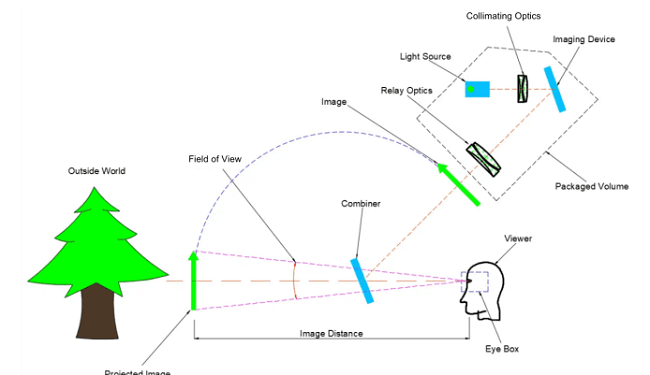The display is arguably one of the most vital components of Augmented Reality (AR) and Virtual Reality (VR) devices because the display is the part of the device responsible for showing virtual images to the user. Optics are central to ensuring that a display is high quality and comfortable to use.
Two types of displays are most commonly employed in AR/VR devices: near-eye displays and projection displays.
Devices like VR headsets utilize near-eye displays, because the display is positioned very close to the user’s eyes in these devices. Devices like AR smart glasses will make use of projection displays, with these devices projecting virtual images onto a semi-transparent screen positioned some distance in front of the user’s eyes.

Image Credit: Avantier Inc.
Both these types of display employ a range of optical components - including mirrors, lenses, and waveguides - to control the light emitted from the display and ensure this is appropriately directed towards the user’s eyes.
For example, lenses are used in a near-eye display to focus light from the display onto the user’s eyes, while mirrors and waveguides are used in a projection display to reflect and direct light towards the eyes of the user.

AR Schematic Diagram. Image Credit: Avantier Inc.
Enhancing Performance and Immersion
Optical coatings also see widespread use in AR/VR displays, particularly where there is a need to improve the displays’ performance. For example, it is possible to apply anti-reflection coatings to lenses and other optical components to lessen glare and enhance image clarity.
Both AR and Mixed Reality (MR) devices use transparent displays to overlay virtual content onto the user’s view of the real world. Precise control over the direction and angle of light transmitted through the display is required in these devices, and it is often necessary to adjust the optical system’s focal length to match the distance of the virtual objects.
AR and MR devices may also make use of waveguides and other optical elements to direct and shape the light in different ways, depending on the application in question.
In contrast, VR employs opaque displays to fully immerse the user in a virtual environment. Optics are a key consideration for VR systems because the display is required to show a convincing three-dimensional image that appears to be at a fixed distance from the user, even as their head and eyes move.
Therefore, VR systems must leverage powerful, high-resolution displays with a wide field of view, as well as advanced optical systems able to adjust the focus and alignment of the image for each user’s eye.
Challenges in AR/VR/MR Applications
A number of challenges remain in the field of contemporary augmented reality, virtual reality, and mixed reality applications.
Field of View
A wide field of view is required in order to create a convincing virtual overlay on the user’s view of the real world. The creation of a wide field of view frequently results in the presence of optical aberrations and distortion, which can lower image quality and adversely affect the user’s experience.
Depth Perception
Creating a convincing three-dimensional image requires precise control over the convergence and proper accommodation of the user’s eyes. Current display technology can struggle to meet these requirements, often resulting in visual discomfort and fatigue for the user.
Size and Weight
In order to be comfortable and practical for everyday use, devices must be lightweight and compact. However, this can limit the optical system’s potential complexity and negatively impact its capacity to achieve high-quality images. A careful balance must be struck between image quality, portability, and comfort.
Display Resolution
VR systems must employ high-resolution displays to create a convincing virtual environment. As display resolution increases, however, pixel size will decrease, making it difficult to maintain high image quality while simultaneously managing the amount of light reaching the user’s eyes.
Conclusion
Optics continue to play a crucial role in AR/VR/MR devices, and these remain central to enabling the high-quality displays necessary to create truly immersive experiences.
Acknowledgments
Produced from materials originally authored by Avantier Inc.

This information has been sourced, reviewed and adapted from materials provided by Avantier Inc.
For more information on this source, please visit Avantier Inc.